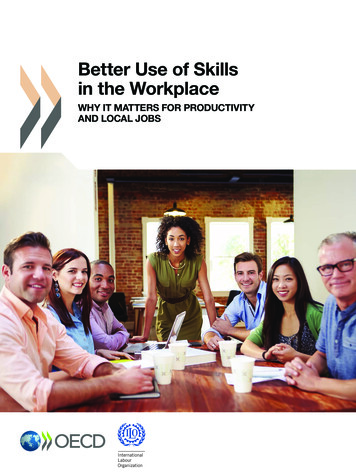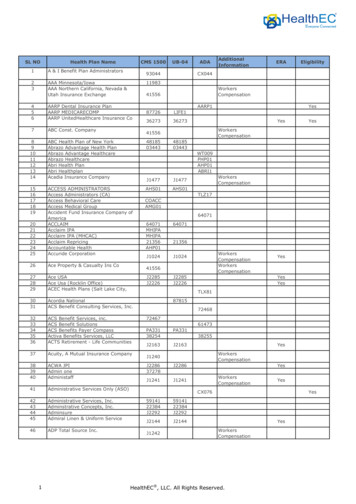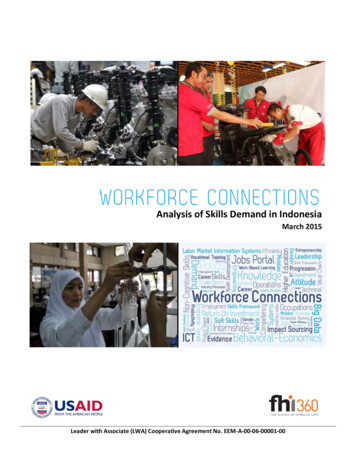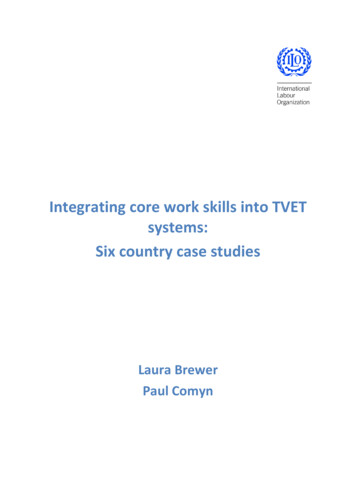
Transcription
Better Use of Skillsin the WorkplaceWhy It Matters for Productivityand Local Jobs
Better Use of Skillsin the WorkplaceWHY IT MATTERS FOR PRODUCTIVITYAND LOCAL JOBS
This work is published under the responsibility of the Secretary-General of the OECD. Theopinions expressed and arguments employed herein do not necessarily reflect the officialviews of OECD member countries, or those of the members of the ILO.This document, as well as any data and map included herein, are without prejudice to thestatus of or sovereignty over any territory, to the delimitation of international frontiers andboundaries and to the name of any territory, city or area.Please cite this publication as:OECD/ILO (2017), Better Use of Skills in the Workplace: Why It Matters for Productivity and Local Jobs,OECD Publishing, BN 978-92-64-28138-7 (print)ISBN 978-92-64-28139-4 (PDF)ISBN 978-92-64-28140-0 (epub)ILO:ISBN 978-92-2-130277-3 (print)ISBN 978-92-2-130278-0 (web pdf)ISBN 978-92-2-130279-7 (epub)The statistical data for Israel are supplied by and under the responsibility of the relevant Israeli authorities. The useof such data by the OECD is without prejudice to the status of the Golan Heights, East Jerusalem and Israelisettlements in the West Bank under the terms of international law.Photo credits: iStockphoto.com/bowdenimages.Corrigenda to OECD publications may be found on line at: www.oecd.org/publishing/corrigenda.htm. OECD, ILO 2017You can copy, download or print OECD content for your own use, and you can include excerpts from OECD publications, databases andmultimedia products in your own documents, presentations, blogs, websites and teaching materials, provided that suitableacknowledgement of OECD as source and copyright owner is given. All requests for public or commercial use and translation rights shouldbe submitted to rights@oecd.org. Requests for permission to photocopy portions of this material for public or commercial use shall beaddressed directly to the Copyright Clearance Center (CCC) at info@copyright.com or the Centre français d’exploitation du droit de copie (CFC)at contact@cfcopies.com.
PREFACEPrefaceThere are both economic and social reasons to look at how to better use skills and talentin the workplace. Workers who better use their skills are more likely to have greater jobsatisfaction, earn better wages and are more prepared to adapt to changes in the nature ofwork. Employers benefit from a more productive and innovative workforce, enabling themto maximise business performance and profitability. Despite these potential benefits,workers across the OECD report that their skills are not fully utilised in the workplace. Thisgap represents a drag on local economic development placing downward pressure on jobquality as well as economic diversification opportunities.Skills utilisation concerns the extent to which skills are effectively applied in theworkplace to maximise employer and individual performance. As such it involves a mix ofpolicies including work organisation, job design, technology adaptation, innovation,employee-employer relations, human resource development practices and businessproduct market strategies. It is often at the local level where the interface of these factorscan best be addressed. Policies which aim to improve skills use in the workplace can helpaddress the multi-faceted challenges many local economies are facing and contribute tonational productivity and inclusive growth objectives.Through case studies of eight OECD and non-OECD countries, this joint publicationfrom the OECD and the ILO explores programme examples which aim to promote a higherlevel of skills use in the workplace. The examples highlight why there is a need to buildpolicy coherence across employment, skills, economic development and innovationpolicies. It also highlights the need to ensure that the issue of skills utilisation is built intopolicy development thinking and implementation.The increasing recognition of the importance of better using skills reflects a newapproach to conceptualising and designing local employment and skills strategies. TheOECD and the ILO remain committed to delivering high quality analysis which aims toembed skills analysis into economic development planning to deliver more inclusive localdevelopment.Lamia Kamal-ChaouiDirector, Centre for Entrepreneurship,SMEs, Local Development and TourismOrganisation for Economic Co-operationand DevelopmentAzita Berar-AwadDirector, Employment Policy DepartmentInternational Labour OrganizationBETTER USE OF SKILLS IN THE WORKPLACE: WHY IT MATTERS FOR PRODUCTIVITY AND LOCAL JOBS OECD, ILO 20173
FOREWORDForewordThe OECD has recently affirmed the importance of increased productivity and continued economicgrowth as means of providing the best opportunity to raise the prosperity and well-being of people.Skills represent the great equalizer and provide a critical route out of poverty and inequality formany individuals. However, traditional approaches to skills have focused on supply as a means ofboosting overall local economic development. Skills utilisation approaches represent a new way ofthinking about public policies, moving away from traditional supply side approaches to focus on howto better work with employers to raise the quality of jobs at the local level and provide employeeswith more autonomy to create innovation in the workplace.This report has been prepared by the Centre for Entrepreneurship, SMEs, Local Development andTourism (CFE) of the Organisation for Economic Co-operation and Development (OECD). It is part of aproject undertaken in co-operation with the United Kingdom Commission for Employment and Skills(UKCES), the Australia Department of Education and Training, and the International LabourOrganization (ILO). This project is coordinated by Jonathan Barr (Head of the Employment and SkillsUnit, OECD LEED Programme) as part of CFE’s Local Economic and Employment Development (LEED)Programme under the direction of Sylvain Giguère, Head of OECD LEED Division.The report was prepared by Anna Rubin (OECD), Jonathan Barr (OECD), Angela Attrey (OECD)and Paul Comyn (ILO). Johnny Sung (Institute for Adult Learning, Singapore) and Chris Warhurst(Warwick University) contributed to Chapter 1. The case studies were drafted by Peter Totterdill(UK Work Organisation Network, United Kingdom); Johnny Sung (Institute for Adult Learning,Singapore); Susan Crandall (University of Massachusetts, United States); Myung Sook Jun (ChonnamNational University, Korea); Phung Trong Hieu (International Labour Organization); Damian Oliver(NSW Skills Board, Australia); Enrique Fernández-Maldonado Mujica (Pontificia Universidad Católicadel Perú, Peru); and Mary Ann Mendoza (International Labour Organisation).This report and overall project also benefited from advice from Chris Warhurst (WarwickUniversity), Ewart Keep (Oxford University) as well as insights and information from participants atan OECD-Commonwealth of Australia workshop on “Engaging employers in skills development forthe 21st Century” in Adelaide, Australia from 2-3 June 2016.Finally, thanks also go to Beatriz Jambrina Canseco for statistical support, François Iglesias andPauline Arbel for production assistance and Janine Treves who provided useful editorial support. Thisreport benefited from comments and advice from Victoria Kis within the OECD Directorate ofEducation (EDU) and Glenda Quintini within the OECD Directorate of Employment, Labour andSocial Affairs (ELS).4BETTER USE OF SKILLS IN THE WORKPLACE: WHY IT MATTERS FOR PRODUCTIVITY AND LOCAL JOBS OECD, ILO 2017
TABLE OF CONTENTSTable of contentsExecutive summary . . . . . . . . . . . . . . . . . . . . . . . . . . . . . . . . . . . . . . . . . . . . . . . . . . . . . . . . .9Chapter 1. Policies and practices for improving skills utilisation locally . . . . . . . . . . . .Introduction. . . . . . . . . . . . . . . . . . . . . . . . . . . . . . . . . . . . . . . . . . . . . . . . . . . . . . . . . . . .Use of skills varies within and across countries . . . . . . . . . . . . . . . . . . . . . . . . . . . . .Putting skills to better use can improve outcomes for individuals, employers,and economies . . . . . . . . . . . . . . . . . . . . . . . . . . . . . . . . . . . . . . . . . . . . . . . . . . . . . . . . .A number of factors influence the degree to which skills are put to good use . . . .Should skills utilisation be in the domain of public actors? . . . . . . . . . . . . . . . . . . .Improving skills utilisation is predicated on policy coherence acrossemployment, skills, economic development and innovation policies . . . . . . . . . . .Policies and programmes that have demonstrated success. . . . . . . . . . . . . . . . . . . .Conclusions and key lessons . . . . . . . . . . . . . . . . . . . . . . . . . . . . . . . . . . . . . . . . . . . . .131416283342Note. . . . . . . . . . . . . . . . . . . . . . . . . . . . . . . . . . . . . . . . . . . . . . . . . . . . . . . . . . . . . . . . . . .44References . . . . . . . . . . . . . . . . . . . . . . . . . . . . . . . . . . . . . . . . . . . . . . . . . . . . . . . . . . . . .44Chapter 2. Collaborative workplace innovation in the East Midlands,United Kingdom . . . . . . . . . . . . . . . . . . . . . . . . . . . . . . . . . . . . . . . . . . . . . . . . . . . . . . . .212326Background . . . . . . . . . . . . . . . . . . . . . . . . . . . . . . . . . . . . . . . . . . . . . . . . . . . . . . . . . . . .Policy rationale for skills utilisation and productivity in the UK . . . . . . . . . . . . . . . .The innovative workplaces programme . . . . . . . . . . . . . . . . . . . . . . . . . . . . . . . . . . . .Governance and Finance . . . . . . . . . . . . . . . . . . . . . . . . . . . . . . . . . . . . . . . . . . . . . . . . .Impact of the innovative workplaces programme . . . . . . . . . . . . . . . . . . . . . . . . . . . .Economic Impact . . . . . . . . . . . . . . . . . . . . . . . . . . . . . . . . . . . . . . . . . . . . . . . . . . . . . . .Strengths of the Innovative Workplaces programme . . . . . . . . . . . . . . . . . . . . . . . . .The scope for improvement . . . . . . . . . . . . . . . . . . . . . . . . . . . . . . . . . . . . . . . . . . . . . .Key learnings regarding transferability of the innovative workplaces approach . .49505053585862626365References . . . . . . . . . . . . . . . . . . . . . . . . . . . . . . . . . . . . . . . . . . . . . . . . . . . . . . . . . . . . .67Chapter 3. Public investment in skills development and utilisation in Singapore . . . .Background . . . . . . . . . . . . . . . . . . . . . . . . . . . . . . . . . . . . . . . . . . . . . . . . . . . . . . . . . . . .71Overview of labour market and skills issues in Singapore . . . . . . . . . . . . . . . . . . . . .Singapore institutional framework supporting skills utilisation. . . . . . . . . . . . . . . .Retail SMP . . . . . . . . . . . . . . . . . . . . . . . . . . . . . . . . . . . . . . . . . . . . . . . . . . . . . . . . . . . . .Biologics SMP. . . . . . . . . . . . . . . . . . . . . . . . . . . . . . . . . . . . . . . . . . . . . . . . . . . . . . . . . . .The Enterprise Training Support scheme and impact on skills utilisation . . . . . . .Conclusion . . . . . . . . . . . . . . . . . . . . . . . . . . . . . . . . . . . . . . . . . . . . . . . . . . . . . . . . . . . . .72727780818388References . . . . . . . . . . . . . . . . . . . . . . . . . . . . . . . . . . . . . . . . . . . . . . . . . . . . . . . . . . . . .89BETTER USE OF SKILLS IN THE WORKPLACE: WHY IT MATTERS FOR PRODUCTIVITY AND LOCAL JOBS OECD, ILO 20175
TABLE OF CONTENTSChapter 4. The open book solutions profit-sharing programme at Paris Creperie,Boston . . . . . . . . . . . . . . . . . . . . . . . . . . . . . . . . . . . . . . . . . . . . . . . . . . . . . . . . . . . . . . . . 91Background . . . . . . . . . . . . . . . . . . . . . . . . . . . . . . . . . . . . . . . . . . . . . . . . . . . . . . . . . . . . 92Description of initiative . . . . . . . . . . . . . . . . . . . . . . . . . . . . . . . . . . . . . . . . . . . . . . . . . . 96Impact of the initiative. . . . . . . . . . . . . . . . . . . . . . . . . . . . . . . . . . . . . . . . . . . . . . . . . . . 99Considerations for expansion and transferability . . . . . . . . . . . . . . . . . . . . . . . . . . . . 103Conclusion . . . . . . . . . . . . . . . . . . . . . . . . . . . . . . . . . . . . . . . . . . . . . . . . . . . . . . . . . . . . . 105References . . . . . . . . . . . . . . . . . . . . . . . . . . . . . . . . . . . . . . . . . . . . . . . . . . . . . . . . . . . . . 106Chapter 5. Meeting the skills needs of local SMEs in Gwangyang, Korea . . . . . . . . . . . 109Background . . . . . . . . . . . . . . . . . . . . . . . . . . . . . . . . . . . . . . . . . . . . . . . . . . . . . . . . . . . . 110Policy context for employment and skills development in Korea . . . . . . . . . . . . . . . 111Case study: LBJCP and CHAMP in Gwangyang . . . . . . . . . . . . . . . . . . . . . . . . . . . . . . . 113Conclusions and lessons . . . . . . . . . . . . . . . . . . . . . . . . . . . . . . . . . . . . . . . . . . . . . . . . . 122References . . . . . . . . . . . . . . . . . . . . . . . . . . . . . . . . . . . . . . . . . . . . . . . . . . . . . . . . . . . . . 123Chapter 6. Investing in employee skills at the local level through Viet Nam’sscore programme . . . . . . . . . . . . . . . . . . . . . . . . . . . . . . . . . . . . . . . . . . . . . . . . . . . . . . . 125Background . . . . . . . . . . . . . . . . . . . . . . . . . . . . . . . . . . . . . . . . . . . . . . . . . . . . . . . . . . . . 126Addressing low productivity in the Vietnamese wood processing industry . . . . . . 129Description of the SCORE Programme . . . . . . . . . . . . . . . . . . . . . . . . . . . . . . . . . . . . . . 129Impacts of the SCORE Programme . . . . . . . . . . . . . . . . . . . . . . . . . . . . . . . . . . . . . . . . . 132Strengths of the SCORE Programme. . . . . . . . . . . . . . . . . . . . . . . . . . . . . . . . . . . . . . . . 137Obstacles observed during implementation. . . . . . . . . . . . . . . . . . . . . . . . . . . . . . . . . 137Potential transferability . . . . . . . . . . . . . . . . . . . . . . . . . . . . . . . . . . . . . . . . . . . . . . . . . . 139References . . . . . . . . . . . . . . . . . . . . . . . . . . . . . . . . . . . . . . . . . . . . . . . . . . . . . . . . . . . . . 140Chapter 7. Local actions to boost skills utilisation Tasmania’s disability services . . . . 143Background . . . . . . . . . . . . . . . . . . . . . . . . . . . . . . . . . . . . . . . . . . . . . . . . . . . . . . . . . . . . 144Workforce development in the Tasmanian Disability Services industry . . . . . . . . . 149Impact. . . . . . . . . . . . . . . . . . . . . . . . . . . . . . . . . . . . . . . . . . . . . . . . . . . . . . . . . . . . . . . . . 154Strengths . . . . . . . . . . . . . . . . . . . . . . . . . . . . . . . . . . . . . . . . . . . . . . . . . . . . . . . . . . . . . . 155Weaknesses . . . . . . . . . . . . . . . . . . . . . . . . . . . . . . . . . . . . . . . . . . . . . . . . . . . . . . . . . . . . 157Conclusions . . . . . . . . . . . . . . . . . . . . . . . . . . . . . . . . . . . . . . . . . . . . . . . . . . . . . . . . . . . . 159References . . . . . . . . . . . . . . . . . . . . . . . . . . . . . . . . . . . . . . . . . . . . . . . . . . . . . . . . . . . . . 160Chapter 8. The Impulsa Perú initiative to improve local worker’s skillsand employability . . . . . . . . . . . . . . . . . . . . . . . . . . . . . . . . . . . . . . . . . . . . . . . . . . . . . . 163Background . . . . . . . . . . . . . . . . . . . . . . . . . . . . . . . . . . . . . . . . . . . . . . . . . . . . . . . . . . . . 164Description of the programme . . . . . . . . . . . . . . . . . . . . . . . . . . . . . . . . . . . . . . . . . . . . 165Governance of the Impulsa Perú Programme . . . . . . . . . . . . . . . . . . . . . . . . . . . . . . . . 165Programme structure and available supports. . . . . . . . . . . . . . . . . . . . . . . . . . . . . . . . 166Impacts of the Impulsa Perú Programme . . . . . . . . . . . . . . . . . . . . . . . . . . . . . . . . . . . 169Strengths of the initiative . . . . . . . . . . . . . . . . . . . . . . . . . . . . . . . . . . . . . . . . . . . . . . . . 170Weaknesses of the initiative . . . . . . . . . . . . . . . . . . . . . . . . . . . . . . . . . . . . . . . . . . . . . . 171What are the main lessons for other emerging countries? . . . . . . . . . . . . . . . . . . . . 172Notes. . . . . . . . . . . . . . . . . . . . . . . . . . . . . . . . . . . . . . . . . . . . . . . . . . . . . . . . . . . . . . . . . . 173References . . . . . . . . . . . . . . . . . . . . . . . . . . . . . . . . . . . . . . . . . . . . . . . . . . . . . . . . . . . . . 1736BETTER USE OF SKILLS IN THE WORKPLACE: WHY IT MATTERS FOR PRODUCTIVITY AND LOCAL JOBS OECD, ILO 2017
TABLE OF CONTENTSChapter 9. Engaging local employers in skills development and utilisationin the Philippines. . . . . . . . . . . . . . . . . . . . . . . . . . . . . . . . . . . . . . . . . . . . . . . . . . . . . . .Background . . . . . . . . . . . . . . . . . . . . . . . . . . . . . . . . . . . . . . . . . . . . . . . . . . . . . . . . . . . .Key Labour Market Challenges . . . . . . . . . . . . . . . . . . . . . . . . . . . . . . . . . . . . . . . . . . . .Private Sector Engagement in TVET . . . . . . . . . . . . . . . . . . . . . . . . . . . . . . . . . . . . . . . .The Training for Work Scholarship Programme . . . . . . . . . . . . . . . . . . . . . . . . . . . . . .Impacts of the Programme . . . . . . . . . . . . . . . . . . . . . . . . . . . . . . . . . . . . . . . . . . . . . . .The Strengths of the Programme . . . . . . . . . . . . . . . . . . . . . . . . . . . . . . . . . . . . . . . . . .Weaknesses of the Programme. . . . . . . . . . . . . . . . . . . . . . . . . . . . . . . . . . . . . . . . . . . .Recommendations to improve the programme . . . . . . . . . . . . . . . . . . . . . . . . . . . . . .Potential Transferability . . . . . . . . . . . . . . . . . . . . . . . . . . . . . . . . . . . . . . . . . . . . . . . . . .175176177178180181185186188191References . . . . . . . . . . . . . . . . . . . . . . . . . . . . . . . . . . . . . . . . . . . . . . . . . . . . . . . . . . . . . 192Tables1.1. Results of UK Employer Skills Survey at the Level of Local EnterprisePartnerships, 2015 . . . . . . . . . . . . . . . . . . . . . . . . . . . . . . . . . . . . . . . . . . . . . . . . . . .Role of Facilitators . . . . . . . . . . . . . . . . . . . . . . . . . . . . . . . . . . . . . . . . . . . . . . . . . . .Profile, aims and outcomes of participant organisations . . . . . . . . . . . . . . . . . .Key labour market statistics, Singapore, 2004 and 2014. . . . . . . . . . . . . . . . . . . .Economic Indicators of Gwangyang Bay Area . . . . . . . . . . . . . . . . . . . . . . . . . . . .Status and Proportion of Programmes . . . . . . . . . . . . . . . . . . . . . . . . . . . . . . . . . .Gwangyang HRD Programme: Partners and Responsibilities . . . . . . . . . . . . . . .Gwangyang HRD Programme Outcomes, 2012-14 . . . . . . . . . . . . . . . . . . . . . . . . .Delivery arrangement . . . . . . . . . . . . . . . . . . . . . . . . . . . . . . . . . . . . . . . . . . . . . . . .Guidelines on co-operation between large companies and SMEs . . . . . . . . . . .Training performance of the POSCO HRD Consortium. . . . . . . . . . . . . . . . . . . . .Training at SCORE. . . . . . . . . . . . . . . . . . . . . . . . . . . . . . . . . . . . . . . . . . . . . . . . . . . .Enterprise characteristics . . . . . . . . . . . . . . . . . . . . . . . . . . . . . . . . . . . . . . . . . . . . .Priorities and outcomes sought in the Tasmanian Disability IndustryWorkforce Development and Skills Plan. . . . . . . . . . . . . . . . . . . . . . . . . . . . . . . . .Skills development priorities with a strong relationship to businessoperations and strategy . . . . . . . . . . . . . . . . . . . . . . . . . . . . . . . . . . . . . . . . . . . . . .Workshop attendance . . . . . . . . . . . . . . . . . . . . . . . . . . . . . . . . . . . . . . . . . . . . . . . .Alignment with best practice principles for regional workforce planningand development . . . . . . . . . . . . . . . . . . . . . . . . . . . . . . . . . . . . . . . . . . . . . . . . . . . .Economically active population (EAP) by employment levels, MetropolitanLima area, 2004-14 . . . . . . . . . . . . . . . . . . . . . . . . . . . . . . . . . . . . . . . . . . . . . . . . . . .Funding for the Impulsa Perú Programme (millions) . . . . . . . . . . . . . . . . . . . . . .Number of beneficiaries by service line, 2012-15 . . . . . . . . . . . . . . . . . . . . . . . . .Impulsa Perú Programme . . . . . . . . . . . . . . . . . . . . . . . . . . . . . . . . . . . . . . . . . . . . .205761741141151161171181191201321331.1. Skill mismatch in literacy across OECD countries . . . . . . . . . . . . . . . . . . . . . . . .1.2. Skill mismatch in numeracy across OECD countries . . . . . . . . . . . . . . . . . . . . . .1.3. Prevalence of High Performance Workplace Practices . . . . . . . . . . . . . . . . . . . . .1.4. Measuring the relationship between supply and demand at the local level. . 6171171FiguresBETTER USE OF SKILLS IN THE WORKPLACE: WHY IT MATTERS FOR PRODUCTIVITY AND LOCAL JOBS OECD, ILO 20171718197
TABLE OF CONTENTS1.5. Comparing the supply for and demand of skills within local economiesin France, 2015 . . . . . . . . . . . . . . . . . . . . . . . . . . . . . . . . . . . . . . . . . . . . . . . . . . . . . .1.6. Labour productivity and the use of reading skills at work. . . . . . . . . . . . . . . . . .1.7. Strategic Skills Model . . . . . . . . . . . . . . . . . . . . . . . . . . . . . . . . . . . . . . . . . . . . . . . .2.1. Engagement and High Performance Working: A National InnovativeWorkplaces System . . . . . . . . . . . . . . . . . . . . . . . . . . . . . . . . . . . . . . . . . . . . . . . . . .3.1. Annual GDP growth rate (%), Singapore, 1976-2015 . . . . . . . . . . . . . . . . . . . . . . .3.2. Age profile of Singapore . . . . . . . . . . . . . . . . . . . . . . . . . . . . . . . . . . . . . . . . . . . . . .3.3. Number of WSQs trainees, 2011-14 . . . . . . . . . . . . . . . . . . . . . . . . . . . . . . . . . . . . .3.4. The Leading Role of the Singapore Workforce Development Agency. . . . . . . . .3.5. The policy provision of SkillsFuture . . . . . . . . . . . . . . . . . . . . . . . . . . . . . . . . . . . .3.6. Future Job Skills in the Retail Sector . . . . . . . . . . . . . . . . . . . . . . . . . . . . . . . . . . . .3.7. Strategic foci of the Retail SMP . . . . . . . . . . . . . . . . . . . . . . . . . . . . . . . . . . . . . . . .3.8. Biologics SMP Priority and Strategies . . . . . . . . . . . . . . . . . . . . . . . . . . . . . . . . . . .4.1. Net Operating Profit YTD, Paris Creperie, 2015-16. . . . . . . . . . . . . . . . . . . . . . . . .4.2. Workforce training fund general program: grant totals awarded by industryFY14 . . . . . . . . . . . . . . . . . . . . . . . . . . . . . . . . . . . . . . . . . . . . . . . . . . . . . . . . . . . . . . .5.1. Map of Gwangyang Bay Area . . . . . . . . . . . . . . . . . . . . . . . . . . . . . . . . . . . . . . . . . .5.2. Members of POSCO HRD Consortium . . . . . . . . . . . . . . . . . . . . . . . . . . . . . . . . . . .6.1. Structure of Vietnamese wooden product exports in the first 8 months of 2015 . . .6.2. Implementation Strategy for the SCORE Programme . . . . . . . . . . . . . . . . . . . . . .6.4. Activities of the SCORE programme . . . . . . . . . . . . . . . . . . . . . . . . . . . . . . . . . . . .6.3. SCORE programme modules. . . . . . . . . . . . . . . . . . . . . . . . . . . . . . . . . . . . . . . . . . .6.5. SCORE Programme Management Structure . . . . . . . . . . . . . . . . . . . . . . . . . . . . . .6.6. Constituents of the SCORE Programme . . . . . . . . . . . . . . . . . . . . . . . . . . . . . . . . .6.7. Characteristics of SME staff trained in workshops . . . . . . . . . . . . . . . . . . . . . . . .6.8. Demographics of SME staff trained in workshops . . . . . . . . . . . . . . . . . . . . . . . .6.9. Staff demographics of SMEs participating in the SCORE Programme, 2015 . . .6.10. Adoption of good practices from SCORE. . . . . . . . . . . . . . . . . . . . . . . . . . . . . . . . .6.11. Percentage of SMEs that report improvements following SCORE training . . . .8.1. Funding of the Impulsa Perú Programme. . . . . . . . . . . . . . . . . . . . . . . . . . . . . . . .8.2. Beneficiaries of the Impulsa Perú Programme. . . . . . . . . . . . . . . . . . . . . . . . . . . 2133134134135135136166170Follow OECD Publications on:http://twitter.com/OECD ://www.oecd.org/oecddirect/BETTER USE OF SKILLS IN THE WORKPLACE: WHY IT MATTERS FOR PRODUCTIVITY AND LOCAL JOBS OECD, ILO 2017
Better Use of Skills in the WorkplaceWhy It Matters for Productivity and Local Jobs OECD, ILO 2017Executive summaryOECD countries face two intertwined policy challenges: a long-term decline inproductivity has occurred over the last two decades, while the gains in economic growthhave increasingly accrued to those already at the top of the distribution of income andwealth. The impacts of this phenomenon are felt most at the local level, where economicwelfare and well-being outcomes re-inforce each other. In response, skills have emerged asa key policy solution. Promoting the increased use of skills can help employers movetowards higher value-added employment and maximize business performance. Moreproductive jobs tend to be of higher quality and have higher wages, thereby improvingsocial and economic outcomes at the local level.Policy makers have largely focussed on boosting the supply of skills, namely thenumber of people with vocational or academic qualifications. Relatively little policyattention has been paid to the use of skills in the workforce and the alignment between thecompetences of workers with the needs of the business. This is despite evidence from theOECD indicating that surveyed workers report not maximising in their use of literacy andnumeracy skills in the workplace.Promoting increased skills utilisation requires a new response at the local level. Part ofthe response falls within the traditional purview of public policy, including programmes toboost innovation and vocational education and training. Another critical factor involvesworking more directly with employers to look at issues related to work organisation, jobdesign and human resource development practices. This requires a move away from policysilos, which can build up at the local level, to bring together employment services, trainingpolicies, economic development organisations as well as innovation programmes.This joint OECD-ILO report provides a comparative analysis of programme examplesfocusing on improving skills use in the workplace across eight countries. The case studiesprovide insights into the practical ways in which employers interact with governmentservices and policies at the local level. The following key lessons and recommendationsemerge from this report:Key lessons and recommendationsSkills utilisation should be identified as a priority across policies in addition to beingthe focus of targeted local interventionsIssues related to skills use are not systematically identified as a policy priority. Policymakers at the local, regional and national levels should articulate skills use as a strategicpolicy priority and consider what types of incentives are required to better engageemployers in examining how they could more effectively use the skills of their employees.The case studies from Singapore, Vietnam, and Peru highlight the ability to use financing9
EXECUTIVE SUMMARYmodels (e.g. grants and tax credits) to incentivise the increased use of skills in theworkplace.Leadership by employers and high levels of employer and worker engagementis requiredFor change to occur in workplaces, employers must have significant buy-in andinvestment in the benefits of prioritising and developing human resources. While publicinterventions can help to incentivise actions by employers, workforce development mustbe a functional part of an enterprise’s business model in order to be sustainable in themedium- to long-term.The most successful changes that occur at the enterprise level are often industry-led,particularly by employer groups or chambers of commerce. Workers and their representativesare also valuable partners in efforts to raise labour productivity and skills utilisation in theworkplace. The case study from Australia in this publication highlights the importance ofleadership from employer representative bodies to ensure that workforce developmentactivities are systematically embedded across an entire industry rather than a singleemployer.Specialised, technical expertise is needed to get employer buy-in and affect changeBetter skills use requires a number of intertwined local- and business-levelconsiderations that are often outside the traditional portfolio of public policies, therefore itcan be helpful to work with an anchor institution or brokers at the local level that havespecialised technical expertise to offer to employers on work organisation, job design,human resource development practices. Such organisations include vocational educationand training institutions, sector councils, human resources consulting firms and otherbusiness associations. Unions are a
here are both economic and social reasons to look at how to better use skills and talent in the workplace. Workers who better use their skills are more likely to have greater job satisfaction, earn better wages and are more prepared to adapt to changes in the nature of . Policies which aim to improve skills use in the workplace can help










